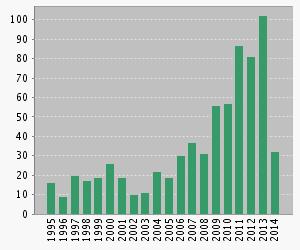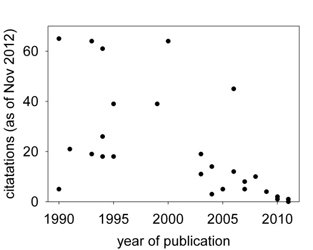Research Interests
Management and restoration of coastal marshes and bottomland hardwood forests is common in the southeastern United States with management being more common on publicly-owned lands and restoration being more common on privately-owned lands. Managers and restoration planners need to know why some wetland restoration and management techniques are more effective in some situations than in others. With my research, I try to help managers and restoration planners understand and better predict the effects of wetland management and restoration. The cost effectiveness of wildlife management and environmental restoration should improve as land managers more accurately predict the impacts of their efforts.
One indication of the impact of my research is citation of my research by fellow researchers. As of April 2014, the Web of Science recognized 33 of my 63 peer-reviewed publications (some were not recognized because they are book chapters; others because they are in journals that are regional or too small). The Web of Science recognized 719 citations (660 omitting self-citations) of those 33 publications. Data from Web of Science indicated that my work was cited with increasing frequency (Figure 1) but recent papers had not yet contributed many citations (Figure 2). The five most cited papers were cited 73 to 82 times. My papers were cited on average 29.96 times per year; the average citation per publication was 21.79. The h-index for these 33 publications was 15, which means that 15 had been cited at least 15 times. According to the Web of Science, the h-index is useful because it discounts the disproportionate weight of highly cited papers and the weight of papers that have not yet been cited.

Figure 1. The number of times 33 of my peer-reviewed articles have been cited annually,
as of April 2014, since my first publication in 1991.

Figure 2. The number of times 31 of my peer-reviewed articles have been cited since
they were published as of October 2013.
Another indication of the impact of my research can be found in the requests for information and advice that I receive from wetland managers and restoration planners. Some of these efforts are extensive enough that they require contractual agreements with the university, such as my recent assistance with the Louisiana 2012 Master Plan for a Sustainable Coast. Others require only a presentation, email, or phone call. The applied impact of my research also is reflected in the Coastal America Partnership Award that I received for my work with the Breaux Act Task Force’s Academic Advisory Group in 2004; in the Team Achievement Award that I received from the US Army Corps of Engineers and the State of Louisiana for my contribution to the Louisiana Coastal Area, Louisiana Ecosystem Restoration Study in 2005; in my invitation from the Louisiana Department of Coastal Protection and Restoration to help them revise the models used to select restoration plans in 2009; and in my invitation from the Louisiana Department of Coastal Protection and Restoration to lead a group of fish and wildlife modelers within the effort to update the state’s 2012 master plan for coastal protection and restoration.